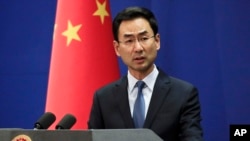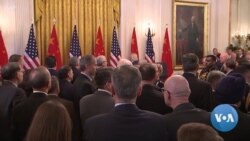The Chinese government is applauding an interim trade agreement with the United States but cautions the two countries must still address key issues of mutual concern.
U.S. President Donald Trump and Chinese Vice Premier Liu He signed the deal Wednesday to resolve what had been an escalating 18-month trade dispute between the world’s largest economies.
"The Phase 1 economic and trade agreement reached between China and the United States is beneficial to both China and the United States, and it is also beneficial to the whole world,” Chinese Foreign Ministry spokesman Geng Shuang said at a news conference Thursday in Beijing.
Geng said the deal “demonstrates once again that China and the United States are capable of finding appropriate approaches and effective solutions through dialogue and consultation on the basis of equality and mutual respect” and that it is imperative the two countries “take care of each other’s core concerns.”
Geng did not provide details about issues of concern but Beijing has said it wants tariffs imposed earlier on most of China’s exports to the U.S. to be lifted.
Trump tweeted early Thursday the pact is “One of the greatest trade deals ever made!” and that it is “Also good for China and our long term relationship.”
At Wednesday’s White House signing ceremony, Vice Premier Liu read a letter from Chinese President Xi Jinping, which said, “In the next step the two sides need to implement the agreement in earnest.”
WATCH: Related video by VOA's Patsy Widakuswara:
Vice Premier Liu read a letter from Chinese President Xi Jinping, which said, “In the next step the two sides need to implement the agreement in earnest.”
Liu, in his own remarks, noted there were setbacks during the process, but that negotiators for both countries did not give up.
The U.S. and China agreed to what they are calling the Phase 1 agreement in mid-December. It calls for China to boost its purchases of U.S. goods, stop the practice of forcing foreign companies to transfer technology, and to not manipulate its currency in order to makes its exports cheaper.
Trump said the second phase of the discussions is to begin quickly and that there will not be a third phase.
Trump said China will import $200 billion worth of additional American products and services over the next two years — $50 billion of that in the agricultural sector.
Xi, in his letter, put the agricultural figure at $40 billion.
According to the text of the agreement, China pledges to buy more than $12.5 billion in U.S. agricultural products in the first year, and $19.5 billion in the second year, with the timing of purchases subject to market conditions.
In his letter to Trump, the Chinese president also called for the U.S. to treat Chinese companies fairly.
Washington already has removed its designation of Beijing as a currency manipulator. Under the deal, the U.S. is halting plans to add new tariffs on billions of dollars’ worth of Chinese goods, while cutting in half tariffs on about $110 billion of Chinese products.
U.S. tariffs will remain in place on about $360 billion of imports from China.
The tough tariffs hurt China economically and brought the Chinese to the negotiating table, National Economic Council Director Larry Kudlow told reporters on Wednesday.
"This is an indisputable win for our country and a momentous day in the U.S.–China economic relationship,” according to National Association of Manufacturers president and CEO Jay Timmons.
Members of the opposition Democratic Party are among those criticizing the deal as weak for U.S. interests.
"True to form, Trump is getting precious little in return for the significant pain and uncertainty he has imposed on our economy, farmers and works,” said former Vice President Joe Biden, a leading candidate for his party’s nomination to challenge Trump for the presidency in November. “The deal won’t actually resolve the real issues at the heart of the dispute.”
House Speaker Nancy Pelosi termed Wednesday’s event “nothing more than a showy television ceremony to try to hide the complete absence of concrete progress, transparency or accountability in this ‘Phase One’ agreement.”
The first phase, which is to go into effect in a month, does not address China's subsidies to state-owned companies, an issue likely to be discussed in the next phase.
U.S. Trade Representative Robert Lighthizer called those subsidies a big problem that is partly offset by the continuing tariffs.
China cannot impose retaliatory tariffs if the United States takes actions against it for violating terms of the agreement, according to a senior administration official, who explained to reporters after the signing event that Beijing’s only option would be to quit the deal. “
I think both sides are reasonably happy with this compromise, even though it doesn't really tackle the core issues,” Edward Alden, a senior fellow at the Council on Foreign Relations, told VOA.










